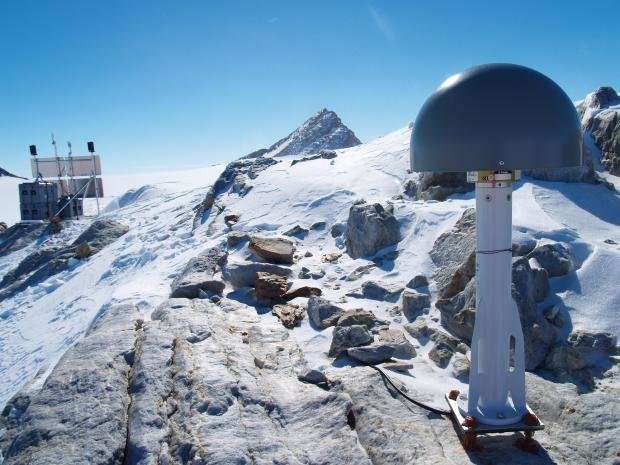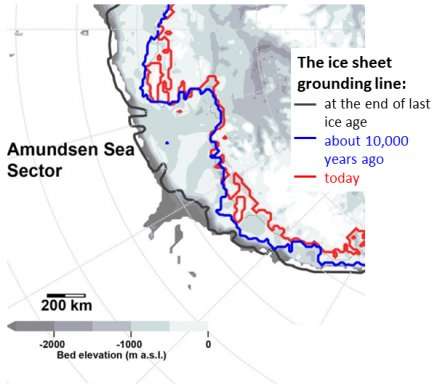How fast can Antarctica rise when the ice melts?

Earth is finally free to rise after hundreds of thousands of years of ice suppression.
That, of course, is a provocative statement, however, from the point of view of the Earth, it is actually true. The Pine Island, Thwaites, Haynes, Smith and Kohler Glaciers, located in the Amundsen Sea Embayment of West Antarctica (see the map below), have been the stars of many alarming headlines regarding the accelerating pace of ice melt, the possible collapse of the West Antarctic ice sheet, and sea level rise.
And it is true: The Amundsen Sea Embayment is one of the most important regions of the world in terms of ice melt.
These glaciers contain enough ice to cover an area the size of Denmark (43,000 square kilometres) with more than 11 kilometres of ice, which would raise the global sea level by 1.2 metres if it were to melt all at once.
That massive amount of ice has been burdening and pushing down on the surface of the Earth since the beginning of last ice age, 115,000 years ago. So, what can we expect as it melts and the pressure it exerts lifts?
Our new study published in Science has some answers.
Parts of West Antarctica are rising
At the peak of the last ice age, ice covered a much larger area of the Amundsen Sea Embayment than it does today, but it shrank to reach its modern configuration around 10,000 years ago, as shown in the figure below.
Since then, the glaciers in this region have been pretty much stable until about 200 years ago, when they started to melt and retreat. This happened slowly at first, but there has been a clear increase of ice loss since 2005.
Our study shows that the Earth surface, progressively relieved from the big burden of ice, is finally rising and it is doing so at an accelerating pace – up to 41 millimetres a year in 2014, which is between four and five times faster than expected.
GPS records the land rising
To see just how the land underneath the ice sheet is responding to recent ice loss, we studied data collected by high-precision GPS (Global Positioning System) instruments placed on remote rock outcrops in West Antarctica.
These GPS sensors work pretty much in the same way as the GPS in your phone or in your car, but they are much more precise and can measure movements of millimetres. Most importantly, the GPS sensors also measure vertical movements (such as rising bedrock) as well as horizontal movements.
In this way, they can actually measure the uplift of the land as the ice sheet melts.
A team led by Professor Terry Wilson at Ohio State University (OSU), installed the sensors more than a decade ago—both GPS and seismic stations.
After what I would say was a heroic effort to install and maintain the network of sensors in one of the least accessible places on the planet, the team has been rewarded with incredibly valuable data, which tell an incredible story about the Earth.
Specifically, we discovered a very different Earth structure than was previously thought to exist underneath the ice sheet, which is driving the bedrock beneath the ice to rise faster than expected.

Why does the land rise when the ice melts?
To explain this, we need to understand the process by which the earth rises, known as glacial isostatic adjustment to give it its proper name.
A useful analogy is to imagine the structure of the Earth beneath Antarctica as a double-layer mattress with a springy, elastic layer at the top and a thick, memory foam underneath.
As the ice thins, the land immediately underneath the ice sheet quickly springs back in response to the loss of weight. This is like the springy layer at the top of your mattress, which springs back as you get out of bed. This immediate response is called elastic rebound.
Secondly, there is a delayed uplift as the mantle beneath the bedrock responds. This is analogous to the deeper memory foam layer of the mattress. Like the memory foam, the mantle 'remembers' its past load for a while before slowly creeping back to its original, unloaded shape.
If the mantle is stiff, this delayed uplift, occurs very slowly on time scales of millennia or more. This is what we see today in North America and in Scandinavia, where the land is still rising (by one centimetre per year) to 'erase' the footprint left by the vast ice sheets that once covered the northern hemisphere during the last ice age.
Conversely, if the mantle is soft and full of water, it will be far less viscous (i.e. less resistant to flow), and will respond much more rapidly to a loss of ice above. In this case, the mantle 'memory' will only persist for decades to centuries and uplift will mostly depend on recent ice loss. The more uplift we see, the softer the mantle underneath.
It is this fast surface response that we have now detected underneath Antarctica, suggesting the presence of a soft mantle.
A softer mantle than expected
A soft and warm mantle is typically found in very active tectonic areas at the edge of tectonic plates. And very fast uplift rates, like those recorded in our study, only occur where ice is also actively melting, such as Alaska (also here and here), Iceland (also here), and Patagonia.
Although the Amundsen Sea Embayment is not tectonically active, it does share some common features with these places, including the presence of volcanoes and rift systems. So, we expected to see a little bit of a delayed rebound (uplift) on top of the instantaneous elastic response. But what we found went beyond our wildest imagination.
With GPS, we measured (and continue to measure) an uplift rate up to five times faster than the elastic rebound, which means that the mantle is very soft.
This is 100 times less viscous than below North America, and 10 times less viscous than what we had expected.
Profound implications for the future projection of the global sea level rise
Our results have a number of important implications for scientists to study further, such as improving our knowledge of the solid Earth response to the ice melting processes in Antarctica, which in turn is very important to understand the long-term sea level evolution of the ice age cycle.
But it is the implications for the very short-term contribution to sea level rise that caught many people's attention, as rising bedrock could slow down ice retreat and perhaps even protect the ice sheet from collapse.
We have not yet investigated these implications and the processes involved are complex, but clarifying them will certainly improve the reliability of the future projections of sea level rise in the race against climate change. We will explore this in more detail in the next article.
More information: Valentina R. Barletta et al. Observed rapid bedrock uplift in Amundsen Sea Embayment promotes ice-sheet stability, Science (2018). DOI: 10.1126/science.aao1447
Journal information: Science
Provided by ScienceNordic
This story is republished courtesy of ScienceNordic, the trusted source for English-language science news from the Nordic countries. Read the original story here.





















